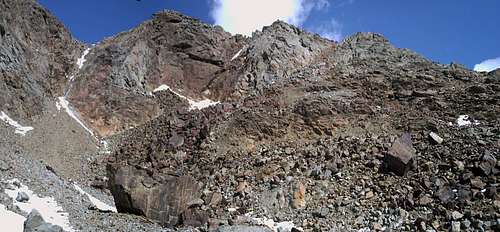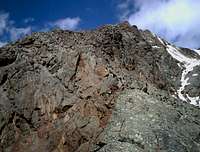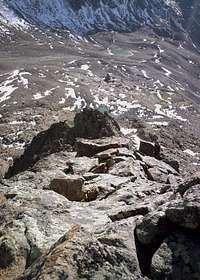Preface
Actually this TR is sort of anti-TR, since neither successes nor spectacular escapes or failures are to be reported. It simply shares the insights of a weekend, which bore out fewer expectancies than it had promised before. Part of that is due to the unexpected experience of mountains visibly falling asunder - dying mountains. What struck me here so unexpectedly is surely no particular property of the particular area of southern Stubai group in the Alps, where this weekend derolled, but can of course also be found elsewhere. Here lies the rationale to share this TR as a general TR, not just as an account in the German corner of SP, where most of the people who know this area belong to. Finally, it also touches the general point that difficulties and wearisome situations are mastered (or not) by the strength of the mind, not primarily by the fitness of the body (although the latter can of course influence the former - and here surely has).
Starting up
![Upper windach valley]() Approach to Siegerland hut
Approach to Siegerland hut![Siegerland hut and Sonklarspitze SW-Face]() Siegerland hut and Sonklarspitze SW face
Siegerland hut and Sonklarspitze SW face
Since several months I had planned for September a traverse of the highest Stubai peaks, from
Sonklarspitze (3467m) in the west to
Wilder Freiger (3418m) in the east. One touches 3 huts, it is a nice 4-day trip with 2 days above 3000m, and I had never before been there. Since it has not been possible with my intended partner, I started on Sept 21st on my own, to explore at least the first summit of the route, Sonklarspitze, which is btw the 4th highest of Stubai. 4 days of sunny autumn conditions were forecasted, after a period of considerable snowfall in higher altitudes. All glaciers could be expected to be under fresh snow, and since I had been warned by the local guide office even to avoid the small glacier Gaiskarferner, which must be crossed when approaching Sonklarspitze from the ski resort Stubai glacier via Hildesheimer Hütte, I chose the long but glacier-free access from Sölden in Ötztal eastward via Windach valley (Tal) to Siegerland hut (Hütte), 2710m. In my pocket I had
JoPo's description of Sonklarspitze's western ascents.
Due to several factors I arrived at Sölden only at 5pm, where I learned that no more bus to the intermediate hut "Fiegls Gasthaus" at 1956m was scheduled, and taxis are no longer allowed on this closed route. So I had no chance to get to Siegerland hut this evening, and I stayed, after walking up these 500m of altitude, at Fiegls Gasthaus, where I arrived at closing dawn. To my surprise this Gasthaus was no noble Austrian tourist hotel, but really a very rustic and romantic accommodation. Thus, instead of tackling Sonklarspitze immediately the next morning, I had first to envisage the 7km walk through the very scenic, slowly rising Windach valley.
I started around 7:45am the next morning and arrived, with several photo breaks, around noon at Siegerland hut. This is of course not very fast, and due to my suboptimal - as I had to realize - fitness and training state, I also took a somewhat elongated break for lunch and rest, and for installing myself in the hut's winter-room. However, no doubt came to my mind to try Sonklarspitze still this afternoon - which proved to be a mistake in the end.
Getting under
It was about 1:30pm - ample 6 hours to dawn - when I started the final ascent. My tiredness notwithstanding I arrived in a reasonable time in the cirque at about 3000m, where the ascent proper, split in 2 alternatives, starts. The old route uses a steep couloir about 100m high (marked in blue in the following image), ending directly at the snow field which leads to Hohes Eis. This couloir is good and fast when under snow, but is now strongly discouraged in summer, and, as it appeared, rightly so, because instead of walkable snow there was a lot of loose scree and in the lower part even a man-sized waterfall.
![Sonklarspitze west pano]() Sonklarspitze SW face
Sonklarspitze SW face![Sonklarspitze SW ridge]() Sonklarspitze SW ridge, looking up
Sonklarspitze SW ridge, looking up![Sonklarspitze SW ridge]() Sonklarspitze SW ridge, looking down to Siegerland hut.
Sonklarspitze SW ridge, looking down to Siegerland hut.![Rent a Helicopter]() The rent-a-helicopter passage
The rent-a-helicopter passage
So I turned my attention to the new summer route, which uses the SW ridge to the right of the couloir (the ascent to this ridge from the cirque is marked in red). Now I have to say that both alternatives looked almost equally deterrent to me, the whole face visible from the cirque appeared simply bust and was very much in contrast to the clear, serene snow walk I had associated Sonklarspitze with. However, having ascended so far in order to summit Sonklarspitze, it was clear that I now tackled the new route.
It was all of a mess right from the start. I believe I have never conquered a gravel field of the sort the 1st 70 m of altitude from the cirque were - a barrier of 2-4m blocks with wide empty space in between, where I proceeded very slowly, delicately and critically balancing from block to block. I admit that this is a subjective assessment, but the only thing which could have inspired me in the physical and mental state I had slipped in would have been a maybe steep, but clear-cut snow line leading up. Thus, while exhaustingly struggling through, I came to ask myself why the hell I had to climb this gravel field, and when I finally arrived at its end, I knew the best name for it: "rent-a-helicopter". Luckily, up to the ridge there were only some meters left, in much better terrain, and the ridge with its warm solid rock proved a nice, albeit quite exposed, climb.
Views all around were already quite impressive, Dolomites, Oetztal Alps, nearby Stubai peaks, and when the ridge flattened after about 50 m of altitude I stopped for a thinking pause. It was already 4pm, and the ridge continued for quite a distance without allowing the snow field to Hohes Eis even to be seen, and I had to avow to myself that it was too late for the summit. My motivation had gone, and I wasn't up to manage the rest of the ascent and the descent in the 3 hours remaining until dawn. The point I had reached, at about 3150m, would be my summit for today, and I stayed breathing its atmosphere for half an hour. But the way back still remained. Still not equipped with a helicopter, I had now to undergo the block field a second time.
Right in the middle of it, to step down a large step I seeked support with my hand from one of the blocks, which suddenly sagged. I tumbled and fell, but luckily only a short way before I picked up my pieces again. My hands burned, the skin being partly abrased. Then I noticed the blood, leaking pertinaciously from my left shin. I had quite a hard time to stop it, the wound, albeit small, was deep and obviously had hit a vein. Finally I was back at the hut when dawn already fell in. I still had some struggle with the stove before I could really relax and relish my astronaut food.
The other day I had to decide what to do. Clearly, I did not want to make the rent-a-helicopter-passage a second time. For a while I pondered to try the couloir, hoping it would be feasible after a cold night. But since it was far from warranted that this would really work, I decided to rather have a look to another couloir leading to the neighboring peak of Schwarzwandspitze, which has also a respectable height of 3358m, and from which Hohes Eis can be reached via a rocky ridge. This couloir is described in the current (2002) edition of the area guide "Klier" as an ice route, but it soon became clear that there's no ice/snow left, it was simply that same sort of gravel shit - and I must say, gravel shit all around, every ascent to Schwarzwandspitze described in Klier imparted even more than Sonklarspitze's W face the impression of a mountain in its lethal state, wrecked and kaput.
![Schwarzwandspitze]() Hohes Eis S face (left) and Schwarzwandspitze W face (right)
Hohes Eis S face (left) and Schwarzwandspitze W face (right)
I turned back after an hour or so, there was simply no motivation to go any further somewhere here, and Sonklarspitze appeared unreachable in my mind. I packed my stuff and started the way to Hildesheimer hut, from where I had planned for the next day the easy, glacier-free ascent of Schussgrubenkogel and/or (depending on Gaisskarferner having a trace or not) of Stubaier Wildspitze. However, when I reached the cirque below Triebenkarlasferner - the NW flank of Sonklarspitze and a popular
springtime ski ascent (Ferner is one of the Austrian words for glacier),
![Sonklarspitze NW face pano]() Sonklarspitze NW face with Triebenkarlasferner
Sonklarspitze NW face with Triebenkarlasferner
I had again to realize that all my motivation was exhausted. Of course at this time of the year also Triebenkarlas glacier conveyed a sad appearance, and the prospects of the ascent to Schussgrubenkogel weren't really much better than my exploration of this morning: glacier-free means gravel, there was no grand design route involved, and I found myself no longer inclined to embark upon this ascent to a relatively inferior peak. Even the ascent to Gamsplatzl, a 3000m-pass before Hildesheimer hut, looked deterrent to me.
My mind felt definitely to be under dying mountains, and I have to stress here "under" - no summiting, I literally rested mentally and physically under what I perceived as a rotten mountain environment. Beautiful traits like the blue-eyed Triebenkar lake, featuring just beside the path against the impressive background of Kitzkogl range, could not change this.
![Beautiful Triebenkar lake]() Nice Triebenkar lake
Nice Triebenkar lake![Scenic detail]() Scenic Windach valley
Scenic Windach valley
After some inner fights, reason against emotion, I decided all of a sudden to turn back, down the Windach valley, reached my car at about 7pm, and drove home where I arrived an hour after midnight.
This time, the mountains had shaken me off.














Comments
Post a Comment